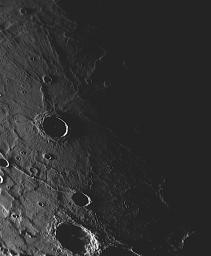
|
The Sun Sets on Rembrandt
- Click the image above for a larger view
- Full-Res JPEG (845 x 1024) (87.6 kB)
- Full-Res TIFF (845 x 1024) (866.4 kB)
Caption:
This NAC image acquired during MESSENGER's third flyby of Mercury a few months ago shows a view of the interior of Rembrandt basin that emphasizes landforms. Rembrandt was discovered during the mission's second Mercury flyby in October 2008. Its large size (715 kilometers, or 444 miles, in diameter), its relatively young age as implied by the low number of superposed impact craters, and the radiating extensional and contractional fractures on its floor have made it a topic of special interest to the MESSENGER Science Team. Earlier this year, an article devoted to the first study of the geology of Rembrandt was published in Science magazine. During Mercury flyby 3, Rembrandt was closer to the terminator , the line between the sunlit dayside and dark nightside of the planet, and the different viewing geometries between flybys 2 and 3 enabled a three-dimensional view of this unusual basin. The grazing angle of the light from the setting Sun in this particular NAC image accentuates the topography of the features on the Rembrandt's floor, including the set of unusual radiating fractures.
Date Acquired:
September 29, 2009
Image Mission Elapsed Time (MET):
162744327
Instrument:
Narrow Angle Camera (NAC) of the Mercury Dual Imaging System (MDIS)
Resolution:
390 meters/pixel (0.24 miles/pixel)
Scale:
The prominent crater at center left is 44 kilometers (27 miles) in diameter
Spacecraft Altitude:
15,100 kilometers (9,400 miles)
Background Info:
These images are from MESSENGER, a NASA Discovery mission to conduct the first orbital study of the innermost planet, Mercury. For information regarding the use of images, see the MESSENGER image use policy .
Cataloging Keywords:
| Name | Value | Additional Values |
|---|---|---|
| Target | Mercury | |
| System | ||
| Target Type | Planet | |
| Mission | MESSENGER | |
| Instrument Host | MESSENGER | |
| Host Type | Orbiter | |
| Instrument | Mercury Dual Imaging System (MDIS) | |
| Detector | Narrow Angle Camera (NAC) | |
| Extra Keywords | Crater, Grayscale, Impact | |
| Acquisition Date | ||
| Release Date | 2009-12-08 | |
| Date in Caption | 2009-09-29 | |
| Image Credit | NASA/Johns Hopkins University Applied Physics Laboratory/Carnegie Institution of Washington | |
| Source | photojournal.jpl.nasa.gov/catalog/PIA12395 | |
| Identifier | PIA12395 | |
